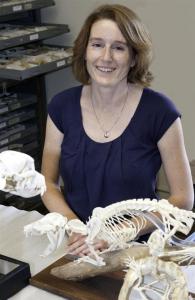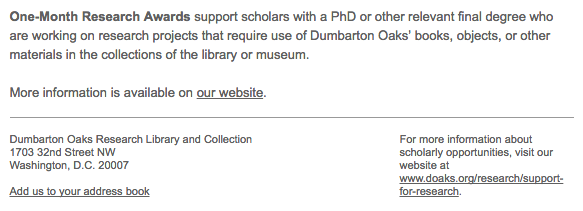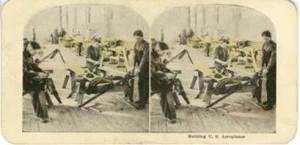In our second post in the series “Curating the Curator: Perspectives from MSMC Committee” I introduce Dr. Barnet “Barney” Pavao-Zuckerman.

Photo by Jannelle Weakly
Dr. Barnet Pavao-Zuckerman is Associate Professor in the Department of Anthropology at the University of Maryland and is the Interim Director for the MSMC Certificate while Dr. Freidenberg is on sabbatical. She received her PhD from the University of Georgia in 2001, completing her dissertation research in the Georgia Museum of Natural History. Prior to arriving at UMD, she was Associate Curator of Zooarchaeology at the Arizona State Museum for over a decade, as well as Associate Professor and Associate Director of the School of Anthropology at the University of Arizona. She is an archaeologist and currently conducting research on the colonial-period experiences of Native Americans in southeastern and southwestern North America.
Having worked extensively in museums with an archaeology background, I asked her: What was your first experience working in a museum, and what was the most important thing you learned? She responded with several stories that wove together why scholarship is important to her work and the challenges and lessons she learned throughout her career.
these “stories” are the result of years of research
I have spent my entire career in museums—in fact, with my move to the University of Maryland last fall, this is the first time in 20 years that I have not worked primarily in a museum setting. My first museum work experience was in the early 1990s, while I was in high school and college. My summer job was as a tour guide at Mount Lebanon Shaker Village, which is in my home town of New Lebanon, NY. I have wonderful memories of my summers at Mount Lebanon—it is a truly remarkable place. Spend an hour wandering through the Village and you understand immediately why the Shakers chose Mount Lebanon as the place to build their most important community. I was an inexperienced teenager, and our small historical site museum operated on a shoe-string budget, but I learned that as long as I could tell a good story, I could send visitors away happy they had come, and with greater knowledge and appreciation for the place and the people who lived there. I quickly learned that these “stories” are the result of years of research by scholars, both within and outside of museums. I read as much as I could about the Shakers, and apprenticed myself to several of the more experienced tour guides, particularly one who was known for his engaging, and sometimes “salty” (and very un-Shaker), tours.
“you know, sometimes we just burned them down when the rats got too much”.
My graduate research, on the study of animal bones from archaeological sites (zooarchaeology), was carried out in the Georgia Museum of Natural History (GMNH), on the campus of the University of Georgia. I went from a mostly open-air historical site museum to a natural history museum, complete with snakes coiled in jars of alcohol. I learned a great deal during my six years at the GMNH. In a natural history museum, museum scholars from diverse disciplines work side-by-side, and my interactions with curators in the natural sciences had a huge impact on my career, including in promoting the role that zooarchaeological knowledge can play in modern wildlife conservation problems. It was also at the GMNH that I first interacted with a living descendent of an archaeological study community. This experience was just the first of many that serve as a constant reminder to consider and question the impact of archaeological research on descendent communities. As I showed our museum visitor the animal bone remains from his ancestral Muscogee-Creek village, I explained to him we had identified a lot of burned rodent bones inside the village’s homes. I told him I had read that in the 18th century, Creek houses were often burned during funeral rituals for heads of household. He looked at me, smiled, and said “you know, sometimes we just burned them down when the rats got too much”. I also learned that sometimes archaeologists privilege the stories they want to tell over the ones that actually make the most sense!
How to make a bunch of dead animals compete with gorgeous ceramics, baskets, and tapestries?
So, we need to be careful about the stories we tell, but to stay relevant in the 21st century, museums have to tell the important and compelling stories. As I grew into a scholar in my own right, I learned to approach the arcana of my own archaeological research to find the stories that reach broad audiences. From 2002 to 2015, I was a faculty curator at the Arizona State Museum (ASM), on the campus of the University of Arizona (with a joint appointment in the School of Anthropology). Behind-the-scenes tours and public lectures were an important part of my position. Museum tour groups would visit ASM’s world-class southwestern Native pottery collections, its state-of-the-art conservation lab, and the new basketry vault (the second of ASM’s Save America’s Treasures projects), and then walk into the zooarchaeology lab, full of old and broken animal bones. How to make a bunch of dead animals compete with gorgeous ceramics, baskets, and tapestries? The rather un-charismatic nature of old bones meant that I had to engage my audience through story, not stuff. After a couple of tries, I was able to engage our audiences with the story of how tiny fragments of animal bones from Native American sites in Alabama and Arizona tell us something about the origins of trans-oceanic trade and the mercantile economy in North America, as well as the role of Native American labor in the emergence of the global economy. Making these connections from the local to the global is, as I would say in my tours, why I love what I do.
I am also thrilled to be part of an institution with a thriving Museum Certificate program
As many of us know, museums face many challenges in the 21st century. Every museum I have worked in since I was a teenager has faced significant financial stress leading to reorganization, staff cuts, or programmatic shrinkage. Lately, the financial strain has been felt especially at state-funded museums, particularly in states that have chosen to balance budget shortfalls on the backs of educational institutions. While I was a curator at ASM, the 100-year old institution experienced unprecedented and crippling budget cuts. The last two years, in particular, were an extremely challenging time at the Museum, as the institution suffered heart-breaking staff losses due to state budget cuts. I miss the day-to-day life of a museum curator, but I am also thrilled to be part of an institution with a thriving Museum Certificate program in a state that invests in all aspects of higher education. I am realistic in my views on the future of museums and museum scholarship, but am committed to helping the students in our Certificate program gain the skills and knowledge that will allow them to thrive in a 21st century museum world.
~ Barney




